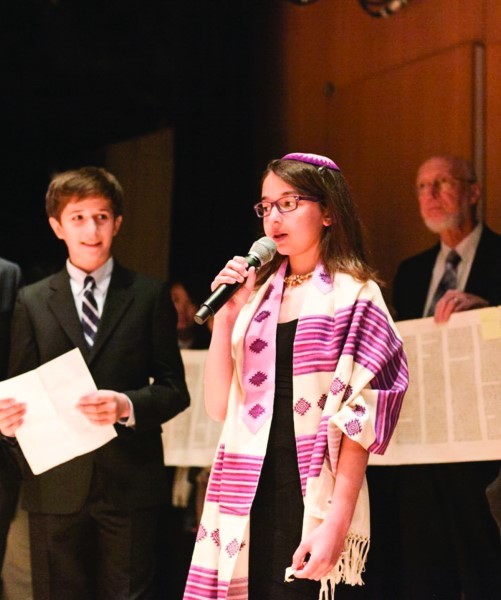Family finds nontraditional group B’nai Mitzvah especially meaningful
BY
(Kveller via JTA) – At my daughter’s recent Bat Mitzvah, hundreds of people spread out to form a large circle and, together, carefully hold a completely unrolled Torah scroll.
With the scroll spread out so that its entire contents were visible, my daughter found the spot on the parchment where the Torah portion corresponding to her Hebrew birthday was located. So did eight other 12- and 13-year-olds.
Standing with their parents at their Torah portion (helpfully indicated in advance with Post-It notes) and going in order from Genesis to Deuteronomy, each child then recited one line from his or her portion.
It’s no surprise that my own daughter’s Bat Mitzvah would be more meaningful to me than anyone else’s, and the novelty of this new ritual added to the specialness. But it was also just a powerful moment – one that while nontraditional also felt respectful and authentic.
Having each child physically stand by his or her Torah portion reinforced the idea that each child has a place in the Jewish story. It empowered all the assembled families and friends to touch the fragile yet sturdy Torah and feel a sense of ownership of it.
Perhaps most important, however, was that this was a group ceremony, not an individual show. And, in contrast to the lavish, wedding-like parties that follow many contemporary American Bar/Bat Mitzvah ceremonies, this was followed by a simple shared party: a tasteful (and tasty) brunch.
Called a brit atid – Hebrew for covenant of/with the future – the ceremony was the culmination of my daughter’s participation in the Jewish Journey Project (JJP), an alternative Jewish education program that describes itself as “experiential Jewish education for the modern New York City kid.”
Launched in 2012 out of the Jewish Community Center in Manhattan, JJP enables kids to choose their own classes, according to their interests and scheduling needs. Students can enroll through the JCC, or through one of the five partnering synagogues. The synagogue kids have a traditional Bar/Bat Mitzvah at their congregation, while the JCC ones can either plan a private Bar/Bat Mitzvah or participate in the brit atid program.
The brit atid ceremony was preceded by a year of monthly parents-and-kids Torah study sessions, along with monthly one-on-one sessions with our teacher, Jeremy Tabick, a doctoral student at the Jewish Theological Seminary. Each child then came up with a creative project to interpret/present his or her portion.
My daughter, who loves filming intricate stop-motion animation sequences starring Playmobil figures and Barbie dolls, created a short and somewhat irreverent film about her Torah portion, followed by a speech addressing the portion’s many problematic aspects. (Not hard, given that the text starts out with God exhorting the Israelites to kill all the Canaanites and show them no mercy!)
Although both my daughter and I worried that the brit atid would feel like a dumbed-down Bat Mitzvah – after all, learning to chant trope is a demanding process – this approach felt more relevant to us than a long performance in a language most of our friends and family do not understand.
Since we don’t regularly attend Shabbat services, learning to chant trope is not a skill my daughter is going to use, at least not in the near future, and it’s not really what being Jewish is about to us. And, like most kids, she’d probably forget the trope within months of the Bat Mitzvah. And learning to chant trope just for the sake of proving that she could master it seemed like cramming for a big test only to forget all the material immediately afterward.
Having a group ceremony had its disadvantages: We were allowed to invite only 30 guests; the ceremony was not anywhere near my daughter’s birthday; and we didn’t get to customize the ceremony or party. However, these were offset by the many advantages, both practical and symbolic.
On the practical end, I’m not much of a party planner, and my husband and I did not want to spend tens of thousands of dollars and countless hours planning a big event. Early on, even before we knew about the brit atid option, we’d decided, with my daughter, that we’d rather put money toward a family trip to Israel than toward a Bat Mitzvah party.
More importantly, I am not a big fan of the individualism of many Bar/Bat Mitzvah celebrations – the professionally produced invitation videos, the myriad speeches praising the child, the “theme” and the photo montage. What’s nice about Judaism, and organized religion in general, is that it provides a counterweight to the individualism and narcissism of modern life, and a group Bar/Bat Mitzvah conveys a message to the newly minted Jewish adult and the guests that Judaism is a collective, participatory endeavor and not just a performance.
Shortly before the brit atid, we attended the more traditional Bar Mitzvah of a close friend – the first one we’ve been to in years – and both my daughter and I had a few pangs of wondering if she, too, should have done the chanting Torah-in-a-synagogue-on-Saturday-morning route. On the plus side, the second-guessing got her competitive juices flowing and motivated her to improve her speech. And, in the end, she said she was very happy with how it went – and is excited about our upcoming trip to Israel.
Now, we just have to convince her almost-10-year-old sister to go the brit atid route as well. Which, given her social butterfly personality and current obsession with planning the perfect “Warriors” book-themed birthday party, might be a challenge.
JULIE WIENER is the managing editor of MyJewishLearning.com.








